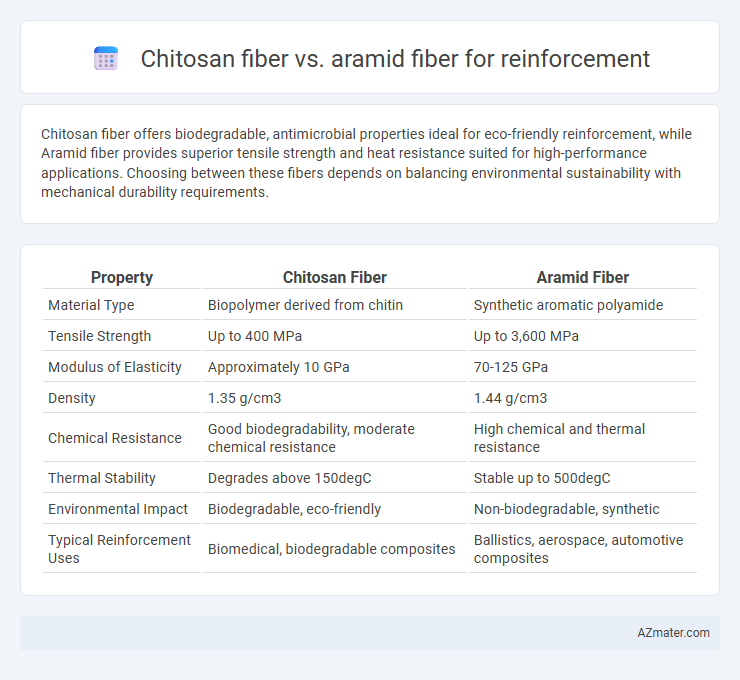Chitosan fiber offers biodegradable, antimicrobial properties ideal for eco-friendly reinforcement, while Aramid fiber provides superior tensile strength and heat resistance suited for high-performance applications. Choosing between these fibers depends on balancing environmental sustainability with mechanical durability requirements.
Table of Comparison
| Property | Chitosan Fiber | Aramid Fiber |
|---|---|---|
| Material Type | Biopolymer derived from chitin | Synthetic aromatic polyamide |
| Tensile Strength | Up to 400 MPa | Up to 3,600 MPa |
| Modulus of Elasticity | Approximately 10 GPa | 70-125 GPa |
| Density | 1.35 g/cm3 | 1.44 g/cm3 |
| Chemical Resistance | Good biodegradability, moderate chemical resistance | High chemical and thermal resistance |
| Thermal Stability | Degrades above 150degC | Stable up to 500degC |
| Environmental Impact | Biodegradable, eco-friendly | Non-biodegradable, synthetic |
| Typical Reinforcement Uses | Biomedical, biodegradable composites | Ballistics, aerospace, automotive composites |
Introduction to Chitosan and Aramid Fibers
Chitosan fiber, derived from the deacetylation of chitin found in crustacean shells, offers biodegradability, biocompatibility, and antimicrobial properties, making it a sustainable option for reinforcement applications. Aramid fiber, a synthetic polymer known for its exceptional tensile strength, heat resistance, and chemical stability, is widely used in aerospace, military, and high-performance composite materials. The choice between chitosan and aramid fibers for reinforcement depends on factors like environmental impact, mechanical performance requirements, and application-specific durability.
Chemical Structure and Composition Comparison
Chitosan fiber is a natural polysaccharide derived from chitin, composed primarily of b-(1-4)-linked D-glucosamine units, offering biodegradability and biocompatibility. Aramid fiber, a synthetic polymer, consists of aromatic polyamide chains with para-oriented benzene rings connected by amide linkages, providing exceptional tensile strength and thermal stability. The chemical structure of chitosan enables hydrophilicity and antimicrobial properties, while aramid's rigid, planar backbone contributes to high mechanical reinforcement performance in composite materials.
Mechanical Properties: Strength and Flexibility
Chitosan fiber exhibits moderate tensile strength and excellent flexibility, making it suitable for applications requiring biocompatibility and lightweight reinforcement. Aramid fiber, known for its superior tensile strength (up to 3,600 MPa) and high modulus of elasticity, offers exceptional resistance to impact and thermal stability, ideal for high-performance reinforcement in composites. While chitosan fibers provide biodegradability and flexibility, aramid fibers outperform in strength and durability, crucial for demanding mechanical reinforcement applications.
Thermal Stability and Resistance
Chitosan fiber demonstrates moderate thermal stability suitable for biodegradable reinforcement applications but degrades at temperatures above 200degC, limiting its use in high-temperature environments. Aramid fiber exhibits exceptional thermal stability, maintaining structural integrity up to 400degC and offering superior resistance to heat and flame, making it ideal for demanding reinforcement tasks in aerospace and automotive sectors. The significant difference in thermal degradation thresholds positions aramid fibers as preferable for high-temperature resistance, whereas chitosan fibers serve well in eco-friendly, low-heat applications.
Environmental Impact and Biodegradability
Chitosan fiber demonstrates superior environmental benefits compared to aramid fiber due to its natural origin and complete biodegradability, enabling it to break down harmlessly in soil and marine environments. Aramid fiber, while offering high tensile strength and thermal resistance, is synthetic and non-biodegradable, leading to persistent environmental pollution and challenges in recycling. The use of chitosan fiber in reinforcement applications significantly reduces carbon footprint and microplastic waste, supporting sustainable material development in composite manufacturing.
Processing Techniques for Reinforcement Applications
Chitosan fiber offers environmentally friendly processing techniques such as electrospinning and solvent casting, enabling lightweight, biodegradable reinforcement in composites. Aramid fiber requires high-temperature spinning and curing processes that provide exceptional mechanical strength and thermal resistance for demanding reinforcement applications. Optimizing processing parameters for chitosan fibers can enhance interfacial bonding, while aramid fibers benefit from controlled tension and heat treatment to maximize durability and performance in reinforced materials.
Cost Analysis and Market Availability
Chitosan fiber offers a cost-effective and biodegradable alternative for reinforcement applications, with production expenses generally lower than aramid fibers due to simpler raw material sourcing from crustacean shells. Aramid fibers, such as Kevlar, command a premium price owing to complex manufacturing processes and high-performance characteristics, which limits their affordability in large-scale projects. Market availability favors aramid fibers due to established industrial supply chains, while chitosan fiber is emerging, with growing interest driven by sustainability but currently limited commercial availability.
Application Suitability in Engineering Fields
Chitosan fiber exhibits excellent biodegradability and antimicrobial properties, making it suitable for biomedical and environmental engineering applications where sustainability and biocompatibility are critical. Aramid fiber offers superior tensile strength, heat resistance, and impact durability, ideal for aerospace, military, and automotive reinforcement where high performance and safety are paramount. Engineering applications demanding lightweight structures with high mechanical strength predominantly favor aramid fibers, whereas eco-friendly and specialized chemical resistance applications increasingly incorporate chitosan fibers.
Durability and Longevity in Composite Materials
Chitosan fiber exhibits moderate durability and biodegradability, making it suitable for eco-friendly reinforcement in composite materials but with limited longevity under harsh environmental conditions. Aramid fiber, known for its exceptional resistance to heat, abrasion, and chemical degradation, offers superior durability and long-term performance in high-stress composite applications. The extended lifespan and mechanical stability of aramid fibers make them preferable for reinforcing composites requiring maximum durability and resistance to wear.
Future Trends in Fiber Reinforcement Technologies
Chitosan fiber, derived from natural biopolymers, offers excellent biodegradability and antimicrobial properties that align with the growing demand for sustainable reinforcement materials. Aramid fiber, known for its exceptional strength-to-weight ratio and thermal stability, continues to dominate high-performance applications such as aerospace and ballistic protection. Future trends in fiber reinforcement technologies emphasize hybrid composites combining chitosan and aramid fibers to balance environmental sustainability with superior mechanical properties.

Infographic: Chitosan fiber vs Aramid fiber for Reinforcement
 azmater.com
azmater.com